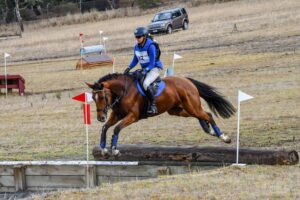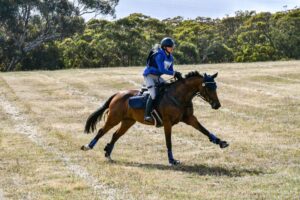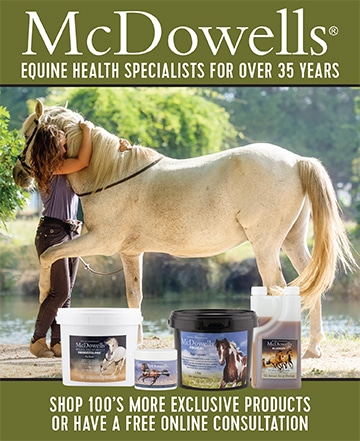In the first two instalments of this series (Cross country training part 2: Training on the arena & 7 Principles For Better Cross Country), 5* eventer Sarah Clark discusses her philosophies for effective cross country riding, then takes us through cross country schooling on the arena. In this final article, we take things out of the arena and onto the course – from simple terrain training, to schooling obstacles confidently, and practicing adjustability in the canter and gallop.
Terrain training
In Part 2 of this series, you would have learned just how simple cross country schooling can be. This also applies to terrain riding, which you can and should do with your horse as soon as you are confident riding them out of the arena.
Hacking out is an essential part of a horse’s cross country training – walking on a long rein up and down hills, over streams, fallen branches, and uneven ground. Sarah says sit back and keep them on a long rein, letting them figure out their own way through and over these ‘obstacles’. By doing it at a slow pace, they have time to develop their coordination, controlling their feet and working out how to use their head and neck for balance.

It also gives you confidence to give your horse control over its own body. When a horse stumbles, our instinct is to grab the reins. It’s important to learn to fight that instinct and allow the horse to use its head and neck rather than the reins for its balance.
While more experienced horses will need to train faster paces over terrain, Sarah includes this slow terrain work in all her horses’ programs.
Taking your arena exercises out on course
Setting up lines on the arena is good training for cross country combinations, but when you add slopes and varied terrain into the mix, suddenly it all changes! If you have drums or skinny poles you use for your arena training, set these up in combination with other fences out on course for coordination and accuracy.
Schooling ditches, banks and water
For these types of obstacles, it’s essential to take the time to build your horse’s confidence from the beginning. You should start slowly and small, preferably in walk on a long rein, so your horse has time to figure out how to negotiate the obstacle successfully.

Developing adjustability and ride-ability
Just as important as the jumps and terrain is your horse’s ability to travel in an open canter or gallop, then come back into a steadier, shorter canter before a fence.

Sarah explains that while many top-level riders look like they’re doing nothing and the horse is adjusting of its own accord, the horse has been trained to be so responsive that we don’t see the adjustments being made. In the beginning though, it’s unlikely to be quite so smooth and subtle. Don’t be afraid to make your aids loud if your horse isn’t coming back to the pace you are asking for.
Sarah uses fitness work as an opportunity to train her horses’ ability to go forward and come back. At all times, she makes sure they have their mind on her and will wait when asked.


